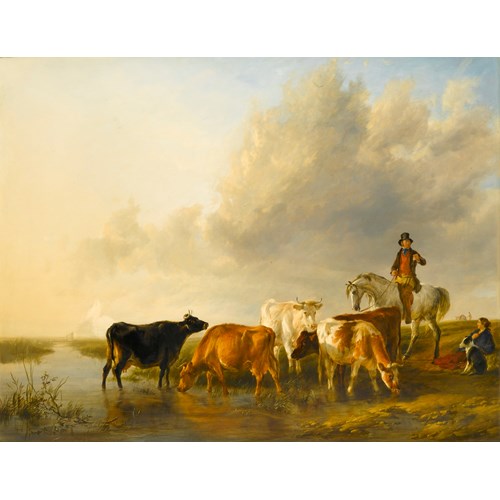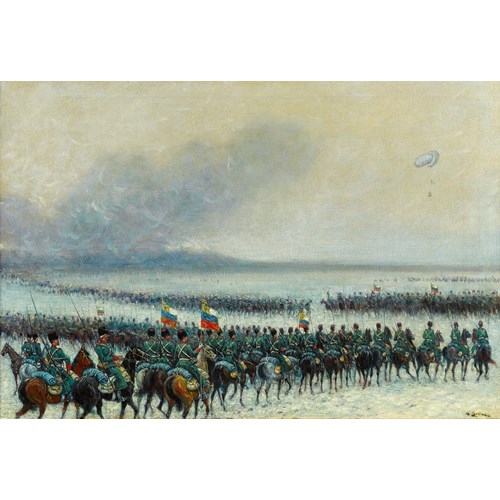Marketplace
Joshua Stopping the Sun
Pauwels Casteels
Joshua Stopping the Sun
Epoque 1600-1750, 17th century
Origine Belgium
Medium Oil on canvas
Dimension 85.1 x 213.2 cm (33¹/₂ x 83⁷/₈ inches)
In this large and engrossing work, Pauwels Casteels has depicted the biblical story of Joshua commanding the sun to stop in the sky. At Gibeon, the Israelites, under Joshua’s command, were fighting against an alliance of Amorite kings, as part of the conquest of Canaan. The Israelites were winning the battle, partly due to God raining hailstones upon the Amorite army, but with the day drawing to a close Joshua commanded ‘Sun, stand thou still upon Gibeon; and thou, Moon, in the valley of Ajalon’.1 Thus sun stopped in the sky, and the day was prolonged until the Israelites could complete their victory over the Amorites.
Casteels has depicted the battle as a chaotic but compelling scene. The composition is a swirl of movement as the armies clash, and the panoramic nature of the composition helps to convey the scale of the battle. The exaggerated undulations of the landscape also contribute to the dynamism of the work, and on the hill on the right-hand side of the painting we see swarms of people fleeing from the hailstones. Amidst this chaos Joshua stands out due to his calmness and composure, appearing almost statuesque in contrast to the churning mass of bodies. Astride a magnificent white horse he appears heroic as he points at the sun, commanding it to stop its progress across the sky.
Unfortunately, little is known about Casteels’ life, although he is recorded in the 1650s by the Guild of St. Luke in Antwerp. He is best known as a battle painter, and his works are noted for their crowded compositions which convey the frenzy of battle. A Siege of a Town (Private Collection) is a comparable work, in that the initial impression is of a heaving mass of battling bodies. However, in both works closer examination reveals how many of the figures have been individualised and so the viewer becomes engrossed by the details of the scene. Joshua Stopping the Sun, is an exceptionally fine example of Casteels’ work, because of its compositional complexity and sophistication, which helps create such a powerful image.
¹ Joshua, 10:12.
Casteels has depicted the battle as a chaotic but compelling scene. The composition is a swirl of movement as the armies clash, and the panoramic nature of the composition helps to convey the scale of the battle. The exaggerated undulations of the landscape also contribute to the dynamism of the work, and on the hill on the right-hand side of the painting we see swarms of people fleeing from the hailstones. Amidst this chaos Joshua stands out due to his calmness and composure, appearing almost statuesque in contrast to the churning mass of bodies. Astride a magnificent white horse he appears heroic as he points at the sun, commanding it to stop its progress across the sky.
Unfortunately, little is known about Casteels’ life, although he is recorded in the 1650s by the Guild of St. Luke in Antwerp. He is best known as a battle painter, and his works are noted for their crowded compositions which convey the frenzy of battle. A Siege of a Town (Private Collection) is a comparable work, in that the initial impression is of a heaving mass of battling bodies. However, in both works closer examination reveals how many of the figures have been individualised and so the viewer becomes engrossed by the details of the scene. Joshua Stopping the Sun, is an exceptionally fine example of Casteels’ work, because of its compositional complexity and sophistication, which helps create such a powerful image.
¹ Joshua, 10:12.
Epoque: 1600-1750, 17th century
Origine: Belgium
Medium: Oil on canvas
Signature: Signed 'PAVWELS CASSTEELS' (lower centre)
Dimension: 85.1 x 213.2 cm (33¹/₂ x 83⁷/₈ inches)
Provenance: Property of a lady of title.
Plus d'œuvres d'art de la Galerie









